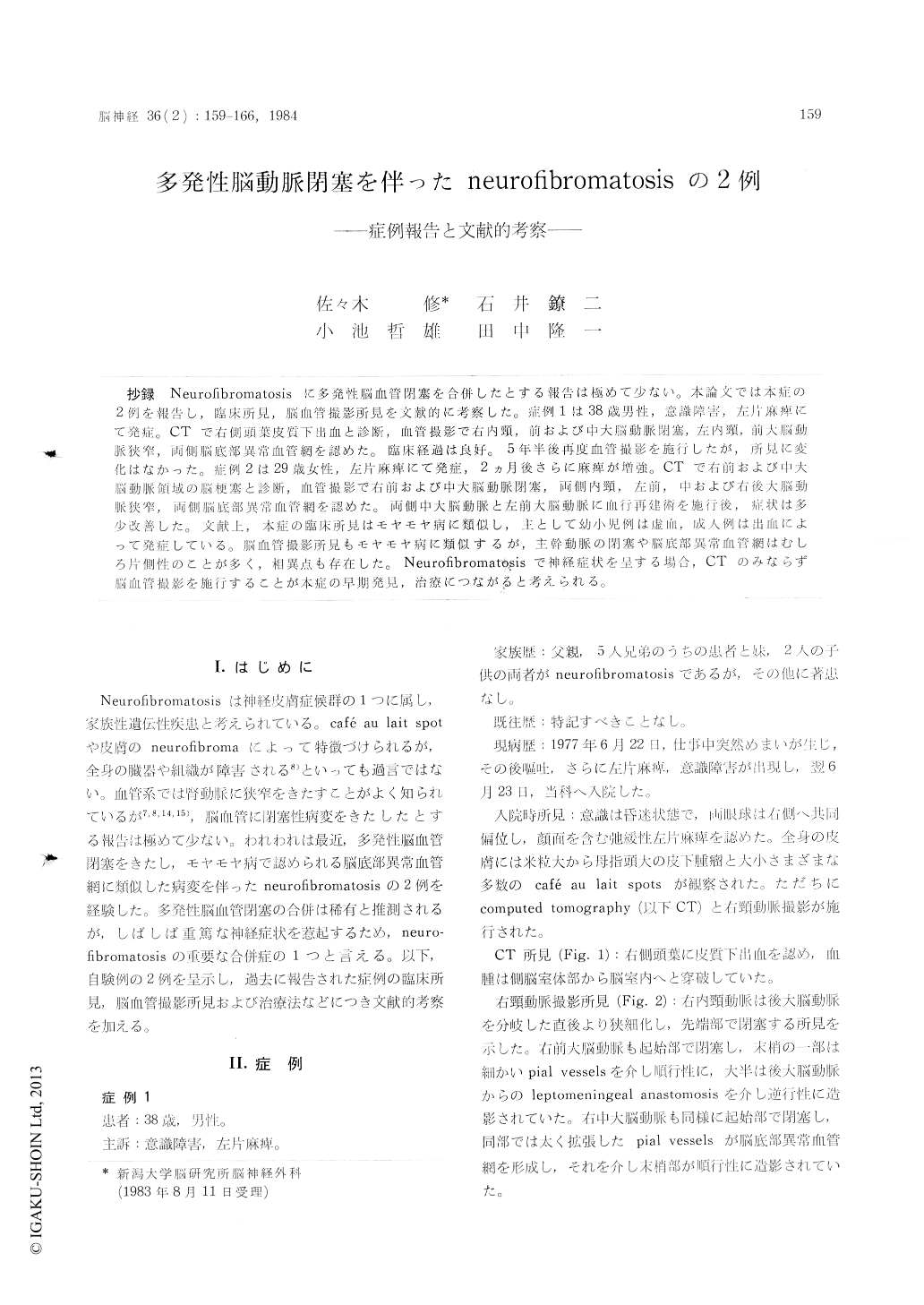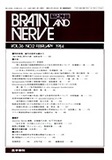Japanese
English
- 有料閲覧
- Abstract 文献概要
- 1ページ目 Look Inside
抄録 Neurofibromatosisに多発性脳血管閉塞を合併したとする報告は極めて少ない。本論文では本症の2例を報告し,臨床所見,脳血管撮影所見を文献的に考察した。症例1は38歳男性,意識障害,左片麻痺にて発症。CTで右側頭艇皮質下出血と診断,血管撮影で右内頸,前および中大脳動脈閉塞,左内頸,前大脳動脈狭窄,両側脳底部異常血管網を認めた。臨床経過は良好。5年半後再度血管撮影を施行したが,所見に変化はなかった。症例2は29歳女性,左片麻痺にて発症,2ヵ月後さらに麻痺が増強。CTで右前および中大脳動脈領域の脳梗塞と診断,血管撮影で右前および中大脳動脈閉塞,両側内頸,左前,中および右後大脳動脈狭窄,両側脳底部異常血管網を認めた。両側中大脳動脈と左前大脳動脈に血行再建術を施行後,症状は多少改善した。文献上,本症の臨床所見はモヤモヤ病に類似し,主として幼小児例は虚血成人例は出血によって発症している。脳血管撮影所見もモヤモヤ病に類似するが,主幹動脈の閉塞や脳底部異常血管網はむしろ片側性のことが多く,相異点も存在した。 Neurofibromatosis で神経症状を呈する場合,CTのみならず脳血管撮影を施有することが本症の早期発見,治療につながると考えられる。
Multiple cerebrovascular occlusive disease is rarely seen in patients with nenrofibromatosis. Two cases of such lesions are presented and literatures dealing with the clinical and angiogra-phical aspects of this occlusive disease are reviewed.
Case 1 ; A 38-year-old normotensive man had sudden onset of vomiting, left hemiparesis and disturbance of consciousness, one day before the admission. He had family history of neurofibroma-tosis, and examination showed cafe au lad spots over the body. CT scans revealed a subcortical hematoma in the right temporal lobe. Angiogram revealed multiple occlusive lesions of the cerebral arteries, including occlusions of the right internal carotid artery (ICA) at the distal end, middle (MCA) and anterior (ACA) cerebral artery at the proximal portion, and stenosis of the left ICA and ACA. Abnormal vascular networks at the base of the brain were also seen bilaterally. Decompressive craniectomy, removal of the hema-toma and bilateral ventricular drainage were performed. Postoperative course was excellent. Angiogram performed five and a half years later, during which time without any surgical procedures, demonstrated no apparent angiographic differences from the previous one.
Case 2; A 29 -year-old woman without family history of neurofibromatosis presented with sudden onset left hemiparesis. Cafe au lad spots were found over the body. A CT scan revealed small infarctions in the territory of the right MCA, and angiogram demonstrated multiple occlusive lesions of the cerebral arteries, including stenosis of the bilateral ICA, the left MCA, both ACAs at the proximal portion, and the right posterior cerebral artery, and occlusions of the right MCA. Abnormal vascular networks at the base of the brain were also demonstrated bilaterally. Two months later, the patient suddenly developed moderately severe paresis of the left leg and mental deterioration. A CT scan suggested a large infarction in the territory of the right ACA, and angiogram revealed occlusion of this artery. Because, in our opinion, the patient had a high risk of a further major cerebral infarction in the territory of both MCAs and the left ACA, a cerebral revascularization procedure was perfor-med ; anastomosis between the right superficial temporal artery (STA) and the left distal ACA, in combination with bilateral STA-MCA anasto-mosis. After surgery, the patient's neurological status was slightly improved and angiogram demonstrated excellent filling of the bilateral ACA and MCA through the anastomoses.

Copyright © 1984, Igaku-Shoin Ltd. All rights reserved.


